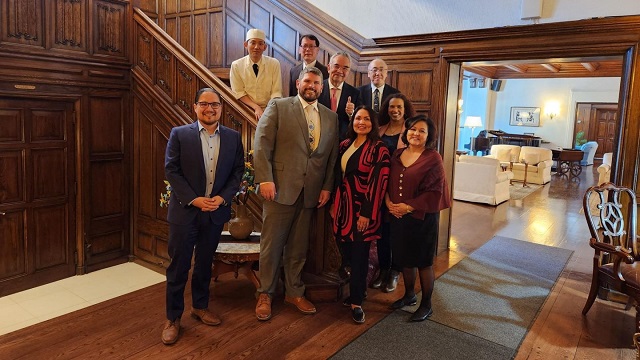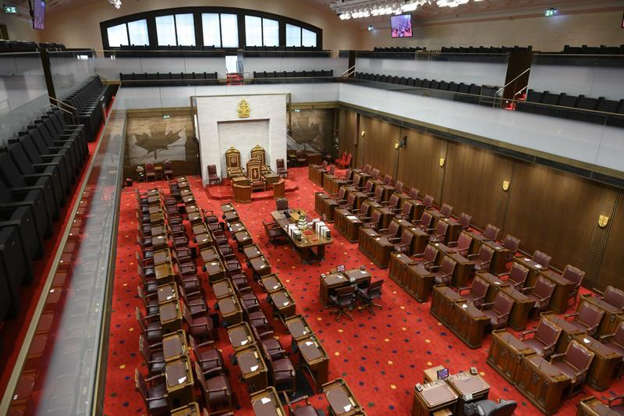Alberta
Indigenous-owned LNG projects in jeopardy with proposed emissions cap, leaders warn

Indigenous leaders meet with Japan’s ambassador to Canada Kanji Yamanouchi. Photo courtesy Energy for a Secure Future
From the Canadian Energy Centre
By Cody Ciona
‘It’s like we’re finally at the table and we’re having to fight to keep our seat at the table’
A proposed cap on oil and gas emissions will threaten opportunities for Indigenous communities to bring cleaner alternatives to coal to international markets, Indigenous leaders warned during a recent webinar.
Karen Ogen, CEO of the First Nations LNG Alliance, fears Indigenous-led projects like Cedar LNG and Ksi Lisims LNG are threatened by the cap, which is essentially a cap on production.
“If we’re going to help China and India get off of coal and help reduce their greenhouse gas emissions, it makes common sense for us to be selling our LNG to Asia and to other countries. To put a cap on, it would just stop us from doing that,” Ogen said.
“It’s like we’re finally at the table and we’re having to fight to keep our seat at the table.”
Indigenous communities across Canada have increasingly become involved in oil and gas projects to secure economic prosperity and reduce on-reserve poverty.
Since 2022, more than 75 First Nations and Metis communities have entered ownership agreements across western Canada. Among those are key projects like the Coastal GasLink pipeline and the joint investment of 23 communities to obtain a 12 per cent ownership stake in several oil sands pipelines.
The planned federal emissions cap will stall progress toward economic reconciliation, Ogen said.
“Our leaders did not accept this and fought hard to have rights and titles recognized,” she said.
“These rights were won through persistence and determination. It’s been a long journey, but we are finally at the table with more control over our destiny.”
Chris Sankey, CEO of Blackfish Enterprises and a former elected councillor for the Lax Kw’alaams Band in B.C., said the proposed emissions cap could stifle Indigenous communities pushing for poverty reduction.
“We’re working hard to try to get our people out of poverty. All [the emissions cap is] doing is pushing them further into debt and further into poverty,” he said.
“When oil and gas is doing well, our people do well.”
Together, the Trans Mountain Pipeline Expansion, LNG Canada project and Coastal GasLink pipeline have spent more than $10 billion in contracts with Indigenous and local businesses
Indigenous employment in the oil and gas industry has also increased by more than 20 per cent since 2014.
For Stephen Buffalo, CEO of the Indian Resource Council, an emissions cap feels like a step in the wrong direction after years of action to become true economic partners is finally making headway.
“Being a participant in the natural resource sector and making true partnerships, has been beneficial for First Nations,” he said.
“So, when you see a government trying to attack this industry in that regard, it is very disheartening.”
Alberta
CPP another example of Albertans’ outsized contribution to Canada

From the Fraser Institute
By Tegan Hill
Amid the economic uncertainty fuelled by Trump’s trade war, its perhaps more important than ever to understand Alberta’s crucial role in the federation and its outsized contribution to programs such as the Canada Pension Plan (CPP).
From 1981 to 2022, Albertan’s net contribution to the CPP—meaning the amount Albertans paid into the program over and above what retirees in Alberta received in CPP payments—was $53.6 billion. In 2022 (the latest year of available data), Albertans’ net contribution to the CPP was $3.0 billion.
During that same period (1981 to 2022), British Columbia was the only other province where residents paid more into the CPP than retirees received in benefits—and Alberta’s contribution was six times greater than B.C.’s contribution. Put differently, residents in seven out of the nine provinces that participate in the CPP (Quebec has its own plan) receive more back in benefits than they contribute to the program.
Albertans pay an outsized contribution to federal and national programs, including the CPP because of the province’s relatively high rates of employment, higher average incomes and younger population (i.e. more workers pay into the CPP and less retirees take from it).
Put simply, Albertan workers have been helping fund the retirement of Canadians from coast to coast for decades, and without Alberta, the CPP would look much different.
How different?
If Alberta withdrew from the CPP and established its own standalone provincial pension plan, Alberta workers would receive the same retirement benefits but at a lower cost (i.e. lower CPP contribution rate deducted from our paycheques) than other Canadians, while the contribution rate—essentially the CPP tax rate—to fund the program would likely need to increase for the rest of the country to maintain the same benefits.
And given current demographic projections, immigration patterns and Alberta’s long history of leading the provinces in economic growth, Albertan workers will likely continue to pay more into the CPP than Albertan retirees get back from it.
Therefore, considering Alberta’s crucial role in national programs, the next federal government—whoever that may be—should undo and prevent policies that negatively impact the province and Albertans ability to contribute to Canada. Think of Bill C-69 (which imposes complex, uncertain and onerous review requirements on major energy projects), Bill C-48 (which bans large oil tankers off B.C.’s northern coast and limits access to Asian markets), an arbitrary cap on oil and gas emissions, numerous other “net-zero” targets, and so on.
Canada faces serious economic challenges, including a trade war with the United States. In times like this, it’s important to remember Alberta’s crucial role in the federation and the outsized contributions of Alberta workers to the wellbeing of Canadians across the country.
Alberta
Made in Alberta! Province makes it easier to support local products with Buy Local program

Show your Alberta side. Buy Local. |
When the going gets tough, Albertans stick together. That’s why Alberta’s government is launching a new campaign to benefit hard-working Albertans.
Global uncertainty is threatening the livelihoods of hard-working Alberta farmers, ranchers, processors and their families. The ‘Buy Local’ campaign, recently launched by Alberta’s government, encourages consumers to eat, drink and buy local to show our unified support for the province’s agriculture and food industry.
The government’s ‘Buy Local’ campaign encourages consumers to buy products from Alberta’s hard-working farmers, ranchers and food processors that produce safe, nutritious food for Albertans, Canadians and the world.
“It’s time to let these hard-working Albertans know we have their back. Now, more than ever, we need to shop local and buy made-in-Alberta products. The next time you are grocery shopping or go out for dinner or a drink with your friends or family, support local to demonstrate your Alberta pride. We are pleased tariffs don’t impact the ag industry right now and will keep advocating for our ag industry.”
Alberta’s government supports consumer choice. We are providing tools to help folks easily identify Alberta- and Canadian-made foods and products. Choosing local products keeps Albertans’ hard-earned dollars in our province. Whether it is farm-fresh vegetables, potatoes, honey, craft beer, frozen food or our world-renowned beef, Alberta has an abundance of fresh foods produced right on our doorstep.
Quick facts
- This summer, Albertans can support local at more than 150 farmers’ markets across the province and meet the folks who make, bake and grow our food.
- In March 2023, the Alberta government launched the ‘Made in Alberta’ voluntary food and beverage labelling program to support local agriculture and food sectors.
- Through direct connections with processors, the program has created the momentum to continue expanding consumer awareness about the ‘Made in Alberta’ label to help shoppers quickly identify foods and beverages produced in our province.
- Made in Alberta product catalogue website
Related information
-

 International2 days ago
International2 days agoPope Francis has died aged 88
-

 International2 days ago
International2 days agoJD Vance was one of the last people to meet Pope Francis
-

 2025 Federal Election1 day ago
2025 Federal Election1 day agoOttawa Confirms China interfering with 2025 federal election: Beijing Seeks to Block Joe Tay’s Election
-

 2025 Federal Election15 hours ago
2025 Federal Election15 hours agoBREAKING: THE FEDERAL BRIEF THAT SHOULD SINK CARNEY
-

 International2 days ago
International2 days agoPope Francis Dies on Day after Easter
-

 COVID-191 day ago
COVID-191 day agoNearly Half of “COVID-19 Deaths” Were Not Due to COVID-19 – Scientific Reports Journal
-

 2025 Federal Election1 day ago
2025 Federal Election1 day agoHow Canada’s Mainstream Media Lost the Public Trust
-

 Business2 days ago
Business2 days agoCanada Urgently Needs A Watchdog For Government Waste






